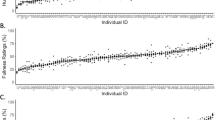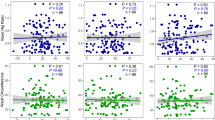Abstract
OBJECTIVE: To investigate the effects of chronic peanut consumption on energy balance and hedonics.
DESIGN: Thirty-week, cross-over, intervention study. Participants were provided 2113±494 kJ/day (505±118 kcal/day) as peanuts for 8 weeks with no dietary guidance (free feeding—FF), 3 weeks with instructions to add peanuts to their customary diet (addition—ADD) and 8 weeks where peanuts replaced an equal amount of other fats in the diet (substitution—SUB).
SUBJECTS: Fifteen, healthy, normal-weight (BMI of 23.3±1.8) adults, aged 33±9 y.
MEASUREMENTS: Dietary intake, appetitive indices, energy expenditure, body weight and hedonics.
RESULTS: During FF, peanut consumption elicited a strong compensatory dietary response (ie subjects compensated for 66% of the energy provided by the nuts) and body weight gain (1.0 kg) was significantly lower than predicted (3.6 kg; P<0.01). When customary dietary fat was replaced with the energy from peanuts, energy intake, as well as body weight, were maintained precisely. Participants were unaware that body weight was a research focus. Resting energy expenditure was increased by 11% after regular peanut consumption for 19 weeks (P<0.01). Chronic consumption of peanuts did not lead to a decline in pleasantness or hunger ratings for peanuts nor did it lead to any hedonic shift for selected snack foods with other taste qualities during any of the three treatments.
CONCLUSIONS: Despite being energy dense, peanuts have a high satiety value and chronic ingestion evokes strong dietary compensation and little change in energy balance.
This is a preview of subscription content, access via your institution
Access options
Subscribe to this journal
Receive 12 print issues and online access
$259.00 per year
only $21.58 per issue
Buy this article
- Purchase on Springer Link
- Instant access to full article PDF
Prices may be subject to local taxes which are calculated during checkout





Similar content being viewed by others
References
Fraser GE, Sabate J, Beeson WL, Strahan TM . A possible protective effect of nut consumption on risk of coronary heart disease. The Adventist Health Study Arch Intern Med 1992 152: 1416–1424.
Hu FB, Stampfer MJ, Manson JE, Rimm EB, Colditz GA, Rosner BA et al. Frequent nut consumption and risk of coronary heart disease in women: prospective cohort study Br Med J 1998 317: 1341–1345.
Prineas RJ, Kushi LH, Folsom AR, Bostick RM, Wu Y . Walnuts and serum lipids New Engl J Med 1993 329: 359–360.
Kris-Etherton PM, Pearson TA, Wan Y, Hargrove RL, Moriarty K, Fishell V et al. High-monounsaturated fatty acid diets lower both plasma cholesterol and triacylglycerol concentration. [See comments.] Am J Clin Nutr 1999 70: 1009–1015.
O'Byrne DJ, Knauft DA, Shireman RB . Low fat-monounsaturated rich diets containing high-oleic peanuts improve serum lipoprotein profiles Lipids 1997 32: 687–695.
Berry EM, Eisenberg S, Haratz D, Friedlander Y, Norman Y, Kaufmann NA et al. Effects of diets rich in monounsaturated fatty acids on plasma lipoproteins—the Jerusalem Nutrition Study: high MUFAs vs high PUFAs Am J Clin Nutr 1991 53: 899–907.
Spiller GA, Jenkins DA, Bosello O, Gates JE, Cragen LN, Bruce B . Nuts and plasma lipids: an almond-based diet lowers LDL-C while preserving HDL-C J Am Coll Nutr 1998 17: 285–290.
Morgan WA, Clayshulte BJ . Pecans lower low-density lipoprotein cholesterol in people with normal lipid levels J Am Diet Assoc 2000 100: 312–318.
Jones Putnam J, Allshouse JE . Food consumption, prices and expenditures, 1970–1997 Statistical Bulletin no. 965. Food and Rural Economics Division, Economic Research Service, US Department of Agriculture 1999.
Burton-Freeman B . Dietary fiber and energy regulation J Nutr 2000 130: 272S–275S.
Holt SH, Miller JC, Petocz P, Farmakalidis E . A satiety index of common foods Eur J Clin Nutr 1995 49: 675–690.
Kirkmeyer SV, Mattes RD . Effects of food attributes on hunger and food intake Int J Obes Relat Metab Disord 2000 24: 1167–1175.
Levine AS, Silvis SE . Absorption of whole peanuts, peanut oil, and peanut butter New Engl J Med 1980 303: 917–918.
Marken Lichtenbelt WD, Mensink RP, Westerterp KR . The effect of fat composition of the diet on energy metabolism Z Ernahrungswiss 1997 36: 303–305.
Swaminathan R, King RF, Holmfield J, Siwek RA, Baker M, Wales JK . Thermic effect of feeding carbohydrate, fat, protein and mixed meal in lean and obese subjects Am J Clin Nutr 1985 42: 177–181.
Leyton J, Drury PJ, Crawford MA . Differential oxidation of saturated and unsaturated fatty acids in vivo in the rat Br J Nutr 1987 57: 383–393.
Shimomura Y, Tamura T, Suzuki M . Less body fat accumulation in rats fed a safflower oil diet than in rats fed a beef tallow diet J Nutr 1990 120: 1291–1296.
Pliner P . The effects of mere exposure on liking for edible substances Appetite 1982 3: 283–290.
Schutz HG, Pilgrim FJ . A field study of food monotony Psychol Rep 1958 4: 559–565.
Hetherington MM, Bell A, Rolls BJ . Effects of repeat consumption on pleasantness, preference and intake Br Food J 2000 102: 507–521.
Rolls ET, de Waal AW . Long-term sensory-specific satiety: evidence from an Ethiopian refugee camp Physiol Behav 1985 34: 1017–1020.
Stunkard AJ, Messick S . The three-factor eating questionnaire to measure dietary restraint, disinhibition and hunger J Psychosom Res 1985 29: 71–83.
The American Dietetic Association. Exchange lists for weight management The American Dietetic Association: Chicago, IL 1995.
Goldberg GR, Black AE, Jebb SA, Cole TJ, Murgatroyd PR, Coward WA et al. Critical evaluation of energy intake data using fundamental principles of energy physiology: 1. Derivation of cut-off limits to identify under-recording Eur J Clin Nutr 1991 45: 569–581.
Weir JB . New methods for calculating metabolic rate with special reference to protein metabolism J Physiol 1949 109: 1–9.
National Research Council. RDA 10th edn National Academy of Sciences 1989.
Sallis JF, Haskell WL, Wood PD, Fortmann SP, Rogers T, Blair SN et al. Physical activity assessment methodology in the Five-City Project Am J Epidemiol 1985 121: 91–106.
Lepage G, Roy CC . Direct transesterification of all classes of lipids in a one-step reaction J Lipid Res 1986 27: 114–120.
US Department of Agriculture, Agricultural Research Service. USDA Nutrient Database for Standard Reference, Release 13 www.nal.usda.gov/fnic/foodcomp 1999.
Connor WE, Lin DS, Thomas G, Ey F, DeLoughery T, Zhu N . Abnormal phospholipid molecular species of erythrocytes in sickle cell anemia J Lipid Res 1997 38: 2516–2528.
Alper CM, Mattes RD . Effects of chronic peanut consumption on body weight and serum lipid levels in humans Federation of American Societies for Exp Biol J 15 4: 2001.
Fraser G, Jaceldo K, Sabate J, Bennett H, Polehna P . Changes in body weight with a daily supplement of 340 calories from almonds for six months Fed Am Soc Exp Biol J 1999 13: A539.
Mattes RD . Dietary compensation by humans for supplemental energy provided as ethanol or carbohydrate in fluids Physiol Behav 1996 59: 179–187.
DiMeglio DP, Mattes RD . Liquid versus solid carbohydrate: effects on food intake and body weight Int J Obes Relat Metab Disord 2000 24: 794–800.
Zemaitis J, Sabate J . Effect of almond consumption on stool weight and stool fat Fed Am Soc Exp Biol J 2001 15: A602.
Jones PJ, Schoeller DA . Polyunsaturated:saturated ratio of diet fat influences energy substrate utilization in the human Metabolism 1988 37: 145–151.
Vandewater K, Vickers Z . Higher-protein foods produce greater sensory-specific satiety Physiol Behav 1996 59: 579–583.
Acknowledgements
We thank Dr A Awad at the University of Buffalo for biochemical analysis and Leslie Bormann for her technical assistance. Supported by US AID; subgrant no. RD309-022/4092094 (Peanut CRSP).
Author information
Authors and Affiliations
Corresponding author
Rights and permissions
About this article
Cite this article
Alper, C., Mattes, R. Effects of chronic peanut consumption on energy balance and hedonics. Int J Obes 26, 1129–1137 (2002). https://doi.org/10.1038/sj.ijo.0802050
Received:
Revised:
Accepted:
Published:
Issue Date:
DOI: https://doi.org/10.1038/sj.ijo.0802050
Keywords
This article is cited by
-
Acute consumption of a shake containing cashew and Brazil nuts did not affect appetite in overweight subjects: a randomized, cross-over study
European Journal of Nutrition (2021)
-
The low-carbohydrate-diet score is associated with resting metabolic rate: an epidemiologic study among Iranian adults
Journal of Diabetes & Metabolic Disorders (2021)
-
Do dry roasting, lightly salting nuts affect their cardioprotective properties and acceptability?
European Journal of Nutrition (2017)
-
Energy compensation and nutrient displacement following regular consumption of hazelnuts and other energy-dense snack foods in non-obese individuals
European Journal of Nutrition (2017)
-
Nut-enriched bread is an effective and acceptable vehicle to improve regular nut consumption
European Journal of Nutrition (2016)



